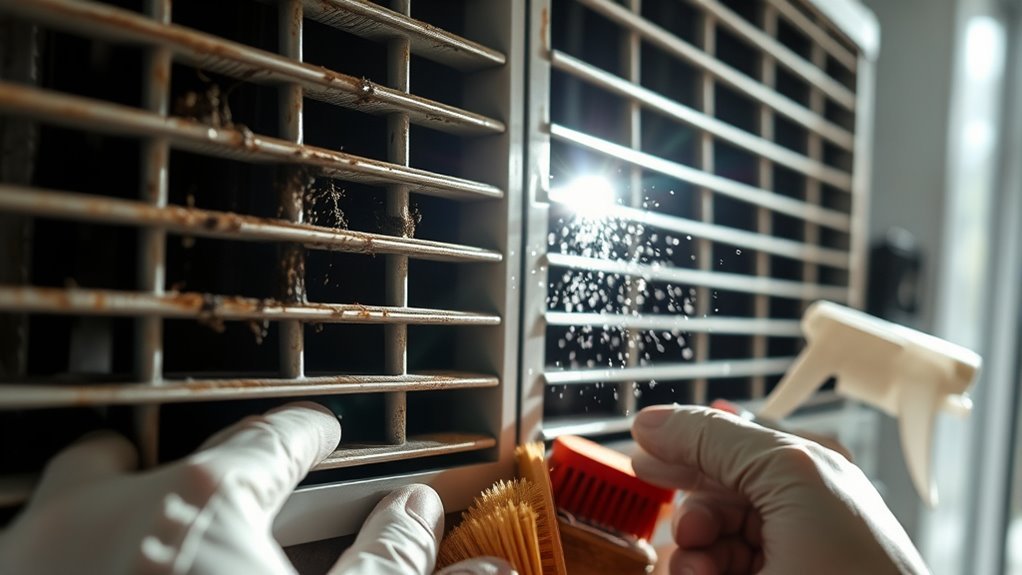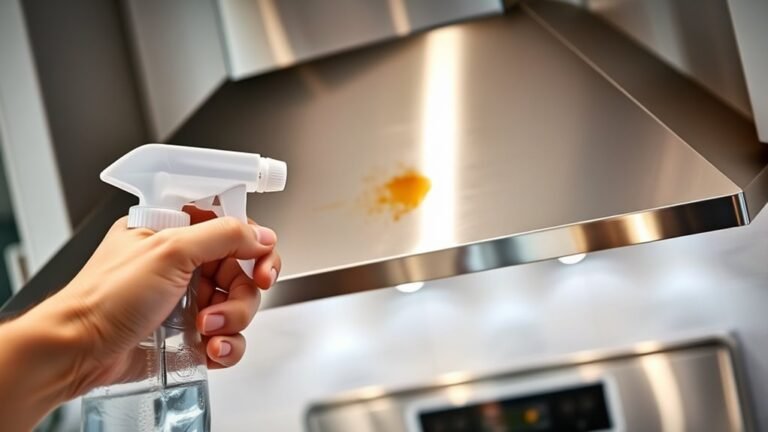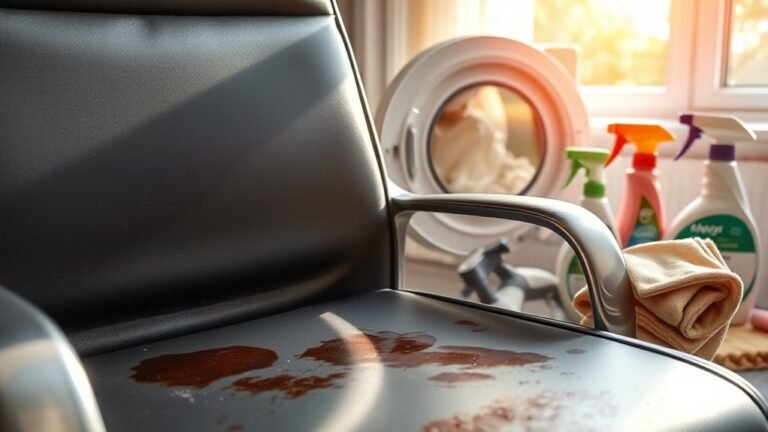How to Remove Stubborn Stains From AC
To remove stubborn stains from your AC, first identify the stain type—mold, mineral deposits, oil-based, etc.—to select the right cleaner. Always disconnect power and wear protective gear for safety. Use soft cloths and non-abrasive sponges with mild detergents or homemade solutions like vinegar or baking soda paste for mineral or grime stains. For oil or mold, you may need specialized commercial cleaners. Proper application and drying prevent damage. Continuing ahead, you’ll find detailed steps and preventive tips to keep your unit spotless.
Understanding Common Types of AC Stains

Although you might not notice them immediately, various types of stains can develop on your AC unit depending on environmental factors and usage. Common AC stains include dust accumulation, mold growth, mineral deposits, and rust. Dust and dirt settle on vents and coils, reducing efficiency. Mold thrives in moisture-prone areas, causing black or greenish spots. Mineral deposits form from hard water exposure, leaving white, crusty residues. Rust appears on metal parts due to prolonged moisture contact. Understanding these common AC stains is essential for selecting effective stain removal techniques. You’ll want to use gentle cleaning solutions for dust, antifungal agents for mold, descaling products for mineral deposits, and rust removers for corroded areas. Proper identification lets you tackle stains efficiently, maintaining your AC’s performance and extending its lifespan.
Safety Precautions Before Cleaning Your AC
Identifying the type of stain on your AC helps determine the appropriate cleaning method, but before you begin any maintenance, safety measures must be in place. First, disconnect the power supply to avoid electrical hazards. Make certain the AC unit is completely off and unplugged before proceeding. Use proper cleaning gear, including gloves and safety goggles, to protect your skin and eyes from harsh chemicals or debris. Work in a well-ventilated area to minimize inhalation risks. Avoid wearing loose clothing that could get caught in components. Familiarize yourself with the AC’s manual for specific safety instructions. Prioritizing personal safety not only prevents injury but also allows you to work efficiently, giving you the freedom to maintain your AC confidently and effectively.
Essential Tools and Materials for Stain Removal

To effectively tackle stubborn stains on your AC, you’ll need a specific set of tools and materials designed for precision and safety. Start with essential cleaning supplies like a soft microfiber cloth, a non-abrasive sponge, and a small brush for detailed areas. Choose a mild detergent or a specialized AC-safe stain remover to avoid damaging surfaces. Gloves protect your hands, while a spray bottle helps apply cleaning solutions evenly. For tougher stains, isopropyl alcohol or white vinegar can be effective, but test them on a hidden spot first. These stain removal techniques combined with the right tools guarantee thorough cleaning without compromising your AC’s integrity. Having these essentials ready lets you maintain your AC with freedom and confidence.
How to Clean the AC Exterior Properly
To clean your AC exterior properly, start by selecting cleaning agents that won’t damage the surface or internal components. Follow a systematic process: gently remove dust, apply the cleaner evenly, and rinse without soaking electrical parts. Finally, protect the finish by avoiding abrasive tools and drying the surface thoroughly.
Choosing Safe Cleaning Agents
Although it might be tempting to use strong chemicals for quick results, selecting safe cleaning agents is crucial to avoid damaging your AC’s exterior components. You’ll want to prioritize eco friendly options that balance stain removal effectiveness with material safety. Avoid abrasive or highly acidic cleaners that can degrade paint or plastic surfaces. Instead, choose mild detergents or specialized AC cleaners formulated to break down grime without harming the unit. Always check product labels for compatibility with metal and plastic parts. Using eco friendly agents not only protects your AC but also reduces environmental impact, aligning with your desire for freedom from harmful substances. Remember, effective stain removal doesn’t require harsh chemicals—careful selection guarantees thorough cleaning while preserving your AC’s integrity and performance.
Step-by-Step Cleaning Process
The cleaning process involves five essential steps to assure your AC exterior is thoroughly cleaned without damage. First, start with stain identification to determine the type of residue—dust, grease, or mold—so you can select the appropriate cleaning techniques. Second, power off the unit and detach any removable panels. Third, gently brush off loose dirt. Fourth, apply a mild cleaning solution suited to the stain type using a soft cloth or sponge, avoiding abrasive materials. Fifth, rinse with clean water and dry with a microfiber cloth to prevent water marks. Following these steps assures effective stain removal while preserving your AC’s surface integrity, giving you the freedom to maintain a clean, functional unit safely and efficiently.
Protecting AC Surface Finish
When cleaning your AC exterior, you’ll want to use materials and methods that preserve the surface finish while effectively removing dirt and stains. Start by selecting a mild, non-abrasive detergent paired with a soft cloth or sponge to avoid scratching. Avoid harsh chemicals and acidic cleaners that can degrade the finish and compromise surface protection. Rinse thoroughly with clean water to remove residue that might cause discoloration or corrosion. After cleaning, apply a protective wax or sealant designed for metal or plastic surfaces, depending on your AC’s exterior material. This step enhances finish preservation by creating a barrier against environmental elements and future stains. Regular maintenance using these precise practices guarantees your AC’s surface remains intact, extending its aesthetic appeal and functional durability without restricting your freedom to clean effectively.
Removing Mold and Mildew From AC Units
Since moisture buildup creates an ideal environment for mold and mildew growth in AC units, addressing these contaminants promptly is essential for maintaining air quality and system efficiency. To effectively manage mold prevention and perform mildew treatment, follow these steps:
Moisture in AC units fosters mold growth; prompt treatment preserves air quality and system efficiency.
- Power off the unit and carefully remove accessible panels to expose affected areas.
- Apply a commercial mildew treatment solution or a mixture of water and vinegar to clean surfaces, using a soft brush to dislodge growth without damaging components.
- Thoroughly dry all treated parts and inspect drain pans and coils for blockages that encourage moisture retention.
Regularly scheduling these maintenance tasks will help you keep your AC unit free from mold and mildew, ensuring peak performance and healthier indoor air.
Techniques for Getting Rid of Dirt and Grime

Addressing mold and mildew is just one aspect of AC maintenance; dirt and grime buildup can also greatly impact your unit’s efficiency and lifespan. To tackle dirt buildup, start by turning off the power and removing the outer casing. Use a soft brush or vacuum with a brush attachment to dislodge loose debris carefully. For stubborn grime, apply a commercial-grade coil cleaner, following manufacturer instructions precisely to avoid damage. Focus on fins and coils, where dirt tends to accumulate, impairing heat exchange. Avoid excessive moisture to prevent corrosion. After cleaning, rinse with a gentle water spray and let the unit dry completely before reassembling. Regular stain removal prevents long-term damage, ensuring your AC runs efficiently and quietly, giving you the freedom to enjoy peak performance without frequent repairs.
Using Homemade Solutions to Tackle Stubborn Stains
Several effective homemade solutions can help you remove stubborn stains from your AC without resorting to harsh chemicals. Using homemade remedies made from natural ingredients gives you control and freedom over what touches your appliance. Here are three practical options:
- Vinegar and Water: Mix equal parts white vinegar and water in a spray bottle. Spray on the stain, let sit for 10 minutes, then wipe with a microfiber cloth. This solution dissolves mineral deposits and mild grime.
- Baking Soda Paste: Combine baking soda with a little water to form a paste. Apply it to the stain, wait 15 minutes, then scrub gently with a soft brush. It lifts tough dirt without scratching surfaces.
- Lemon Juice: Use straight lemon juice for organic stains. Its natural acidity breaks down residues. Rinse with water afterward to prevent any sticky residue.
These natural ingredients offer effective, safe stain removal while preserving your AC’s integrity.
When to Use Commercial AC Cleaners
You should opt for commercial AC cleaners when stains are resistant to homemade solutions or involve grease and mold. Always follow safety guidelines, including wearing gloves and ensuring proper ventilation. Select cleaners from reputable brands that specify compatibility with your AC materials to avoid damage.
Identifying Suitable Stain Types
Although many stains on your AC unit can be managed with household solutions, certain types require commercial cleaners for effective removal. Proper stain identification is essential to choose the right method. You’ll want to focus on these types of stains:
- Oil-based stains – These often come from lubricants or refrigerant leaks and resist typical soap and water treatments.
- Mold and mildew – These biological stains can penetrate surfaces deeply and may need specialized antifungal cleaners.
- Mineral deposits – Hard water leaves behind calcium or lime buildup that household cleaners struggle to dissolve.
Safety Precautions to Follow
When handling commercial AC cleaners, it’s crucial to prioritize safety due to their potent chemical formulations. You must always follow personal protective equipment guidelines to avoid skin irritation, respiratory issues, or eye damage. Use gloves, goggles, and masks as a minimum. Guarantee proper ventilation and never mix cleaners to prevent hazardous reactions.
| Equipment Needed | Purpose | Safety Tip |
|---|---|---|
| Gloves | Protects skin from burns | Use chemical-resistant type |
| Goggles | Shields eyes from splashes | Guarantee a snug fit |
| Respirator Mask | Prevents inhalation of fumes | Choose mask rated for chemicals |
| Protective Clothing | Prevents contact with skin | Wear long sleeves and pants |
| Ventilation System | Dilutes airborne chemicals | Open windows or use fans |
Adhering strictly to these guidelines keeps your freedom intact while guaranteeing safety.
Choosing Effective Cleaner Brands
Selecting the right commercial AC cleaner hinges on the stain type and severity, as well as the cleaner’s chemical composition and compatibility with your unit. When stains resist DIY methods, commercial cleaners provide targeted solutions. To choose effectively, consider:
- Analyze cleaner reviews to identify products with proven efficacy against specific stain types, such as mold or grease.
- Utilize product comparisons to evaluate chemical strength, environmental safety, and material compatibility, ensuring no damage to your AC components.
- Confirm the cleaner’s application method aligns with your skill level and equipment available, preventing misuse or incomplete stain removal.
Preventive Measures to Avoid Future Stains
To minimize the risk of stubborn stains forming on your AC, you should implement a regular maintenance routine that includes cleaning filters, inspecting drainage systems, and ensuring proper ventilation. Preventive cleaning is essential; it stops dirt, mold, and mineral deposits from accumulating, which are common causes of tough stains. Schedule routine inspections to identify early signs of wear or blockages, allowing you to address issues before they escalate. Pay special attention to condensate pans and drain lines, as stagnant water can lead to discoloration and corrosion. Maintaining ideal airflow reduces moisture buildup, further preventing stains. By adhering to these preventive measures, you not only protect your AC’s appearance but also enhance its efficiency and lifespan, giving you uninterrupted comfort without the hassle of stubborn stains.
Maintenance Tips to Keep Your AC Spotless
You should establish a regular cleaning schedule to prevent buildup and stains on your AC components. Always use cleaning agents that are specifically designed for air conditioners to avoid damaging sensitive parts. Consistent, proper maintenance guarantees your unit stays spotless and operates efficiently.
Regular Cleaning Schedule
Anyone looking to keep their AC spotless must establish a regular cleaning schedule. Consistent cleaning frequency is essential for effective stain prevention and ideal unit performance. To maintain your AC:
- Inspect and clean the exterior surfaces every two weeks to prevent dirt accumulation that leads to stubborn stains.
- Replace or clean filters monthly, ensuring contaminants don’t embed deeply, which complicates stain removal.
- Schedule a thorough internal cleaning every three months to address hidden buildup and maintain airflow efficiency.
Use Appropriate Cleaning Agents
Selecting the right cleaning agents plays an essential role in maintaining your AC’s cleanliness and efficiency. Different stain types—such as grease, mold, or mineral deposits—require specific cleaning products to guarantee effective removal without damaging components. For grease stains, opt for a degreasing agent designed for electronics or appliances. Mold and mildew demand antifungal cleaners that inhibit growth while being safe for plastic and metal parts. Mineral deposits respond best to mild acidic solutions, like diluted vinegar, but avoid harsh acids that can corrode surfaces. Always check product compatibility with your AC model and test on a small area first. Using appropriate cleaning products not only removes stubborn stains efficiently but also preserves your AC’s functionality, giving you the freedom to maintain a spotless, reliable cooling system.
Frequently Asked Questions
Can Stains Damage AC Internal Components?
Yes, stains can damage your AC’s internal components if left untreated. They often indicate moisture buildup or dirt accumulation, which can corrode parts or reduce efficiency. To avoid this, practicing regular stain prevention and maintenance techniques is key. Keeping your unit clean and dry helps maintain peak function and prolongs freedom from costly repairs. Don’t overlook routine inspections to spot stains early and protect your AC’s longevity.
How Often Should Professional AC Cleaning Be Scheduled?
Think of your AC like a well-oiled machine that needs regular tune-ups to run smoothly. Frequency recommendations usually suggest scheduling professional AC cleaning every 6 to 12 months, depending on usage and environment. This guarantees peak performance and prolongs lifespan. Regular maintenance benefits include improved air quality, energy efficiency, and prevention of costly repairs. By sticking to this schedule, you’ll keep your system free from buildup and enjoy uninterrupted comfort.
Do AC Stains Affect Air Quality or Health?
Yes, AC stains can impact air quality by harboring mold, bacteria, or dust, which circulate through your system. These contaminants can lead to adverse health effects like allergies, respiratory issues, or headaches. To protect your health and maintain ideal air quality, it’s essential to address stains promptly and schedule regular cleanings. Taking these steps guarantees your AC system operates efficiently while safeguarding your indoor environment and personal well-being.
Are There Eco-Friendly Commercial AC Cleaners Available?
They say, “You get what you pay for,” and when it comes to eco-friendly options, that’s true for commercial cleaners too. You’ll find several commercial cleaners designed specifically to be eco friendly, minimizing harmful chemicals while effectively cleaning your AC. These products use biodegradable ingredients and avoid toxins, ensuring both your AC’s efficiency and environmental safety. Choosing them lets you maintain air quality without sacrificing your freedom to protect the planet.
Can Pets Cause Specific Types of AC Stains?
Yes, pets can cause specific AC stains. Pet urine often leads to persistent odor and discoloration inside the unit, while fur buildup restricts airflow and traps dust, contributing to grime accumulation. To maintain peak performance and cleanliness, regularly inspect your AC for these pet-related residues. Addressing pet urine quickly and removing fur buildup through routine cleaning helps prevent long-term damage and guarantees your system runs efficiently and odor-free.






